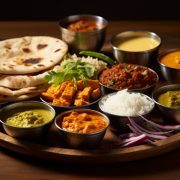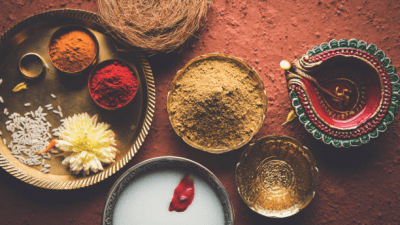Ayurveda is an ancient Indian system of medicine that focuses on the balance and harmony of the body and the mind. It’s an extensive approach where people are known to practice a very specific diet & routine. Ayurveda is an alternative medicine system which uses herbal remedies, special diets, massage, laxatives, and medical oils. Food is central to Ayurveda; it believes that what we eat directly impacts our health, recovery and well-being.
Ayurveda also associates the six distinct tastes with different elements and specifically affects the body. Sweet foods are associated with water and are known to nourish the body tissues, sour food stimulates digestion, salty food supports the nervous system, pungent food promotes circulation, and bitter food helps detoxify the body. Acidic food is associated with water elements and contract tissues.
Ayurveda has a comprehensive guide on food and its effects on the human body. It recommends a balanced diet that includes all six tastes. This ensures that all the body’s tissues and systems are adequately nourished. Ayurveda also considers the sourcing of the food important. Food that is fresh, seasonal and locally grown is most beneficial.
Principles of ayurvedic eating
- Eating regular meals in the right portion
- Eating slowly and mindfully
- Eat only when hungry
- Stop eating when you’re about three-quarters full
- Eat food from different food groups
- Choose fresh, seasonal and locally sourced food
- Avoid processed foods
- Avoid sugary drinks and excessive amounts of caffeine and alcohol
Reaping North Indian Ayurvedic Benefits
North Indian food is known for its rich flavours and spices. They’re also cooked in a way that keeps the nutritional value intact. The seasonal vegetation is taken advantage of, and the cuisine has many ways to celebrate each vegetable/fruit to the fullest calibre. The food is slow-cooked; some of the vegetables are eaten raw, while some others are combined in a way that helps the body absorb the nutrients better.
Examples of North Indian food that offer Ayurvedic Benefits
North Indian ayurvedic benefits include a wide array of foods eaten popularly and not lacking taste. Healthy food doesn’t have to be bland in North Indian cuisine.
- Khichdi – Khichdi is as easy as it gets and is packed with nutrients. It’s easy to make with rice and lentils, which are easy to digest. Khichdi is an excellent source of protein and fibre. With turmeric, salt and other masalas, Khichdi is an ideal food for the sick but with flavour.
- Yoghurt – Yogurt is a fermented dairy product that helps restore the body’s probiotics ratio. Probiotics are beneficial bacteria that help to keep the gut healthy – the most essential element of digestion. Yoghourt helps cool down the body, and Ayurveda advises it be had during daylight hours.
- Ghee – Another dairy product, clarified butter, is easily digestible and has sufficient vitamins A and D. Ghee has anti-inflammatory properties and aids in smoother bowel movements.
- Spices – The very core of North Indian cooking is its spices. Spices such as turmeric, ginger and cumin are commonly used in North Indian cooking and have a lot of health benefits. Turmeric is a powerful antioxidant and an anti-inflammatory agent. Ginger is helpful for digestion and can also relieve nausea and vomiting. It also helps kill harmful bacteria. Cumin is a good source of iron and also manages bloating.
North Indian cuisine can be a healthy and nutritious choice for people who want to live an ayurvedic lifestyle. Choosing recipes that help soak in the most nutrients from the food is to be encouraged. One can have better all-around health by having more authentic drinks and avoiding sugary drinks.
Switch your diet to enjoy north Indian ayurvedic benefits
- Improved digestion – The spices and dishes, like Khichdi and Kadi, help improve digestion. The use of ginger garlic is also prevalent, which helps regulate digestion.
- Reduced inflammation – a fundamental principle of Ayurveda is to regulate the internal body temperature. By eating the right food, one can help keep the body cool. The inflammation is reduced with a dedicated food regime.
- Better immunity – North Indian cuisine uses ingredients rich in antioxidants and other nutrients that help improve immunity. As the focus is on digestion, the parallel benefit is better immunity. Healthy bacteria are maintained while toxins are removed.
- Balance of body and mind – Ayurveda
Final thoughts
Ayurveda, on the face of it, may look like strict food regimes and oil massages. However, the greater picture is the harmony of the body and the mind. It’s ancient but focuses on the right things for a balanced living. Maintaining cortisol levels (the stress hormone), regulating the lymphatic system, focusing on a calm lifestyle and minimal triggers – for the mind and the body. Ayurveda focuses on individual needs and doesn’t have a quick remedy. It takes several days of close observation and treatment.
Also read – Brain Food: 3 Ayurvedic Remedies For Strengthening Memory
A food enthusiast and a blogger – someone who likes to eat and write about it. I’m passionate about exploring different cuisines and challenging my palette. I give into my food craving regularly and am often on the hunt to find my new favorite food place in town.

















[…] Also read- Add a little ghee: Reaping the North Indian Ayurvedic Benefits […]
[…] Also Read- Add a little ghee: Reaping the North Indian Ayurvedic Benefits […]